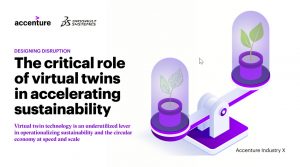It’s widely accepted today that in order to prevent irreversible damage from climate change, we must take urgent action. The level of environmental degradation from current production and consumption models are reaching the point of no return. For example, nearly 90% of the world’s marine fish stocks are now fully exploited, overexploited or depleted. By 2030, we may face a 40% shortfall in freshwater.
The UN Sustainable Development Goals (SDGs) have given companies and governments a clear set of objectives to strive for by 2030, which means we only have a decade to deliver on these commitments.
But prior, incremental approaches are not enough to achieve a carbon-free, ‘circular’ economy within this “decade to deliver.” The world needs more radically disruptive innovations.
While companies, institutions and governments are increasingly setting goals to accomplish sustainability, actual plans are harder to come by. This is in large part because, for all their good intentions, most organizations don’t yet know what steps to take to concretely meet these objectives. Can ‘virtual twin’ technology be the lever to operationalize sustainability and the circular economy at speed and scale?
What are virtual twins?
Virtual twins are real-time, virtual representations of a product, platform or even an ecosystem as complex as a city. Dassault Systèmes’ 3DEXPERIENCE platform is one way to create virtual twins, used to invent, model, and test disruptive innovations. By eliminating the need for physical prototypes, they reduce time to market. By enabling collaboration and rapid design iteration in the virtual world, they reduce the risk associated with complex projects and improve regulatory compliance.
In addition, virtual twins provide safe testing environments for radically disruptive green and circular innovation. By modeling entire value chains, virtual twins can improve the sustainability of products and services across the lifecycle, cradle to cradle: from designing for reuse to minimizing material use during manufacturing to estimating carbon emissions to modeling reverse logistics for circular economy systems.
For example, in the Transportation & Mobility sector, virtual twin technologies accelerate the vehicle concept, detailed design and design verification stages, while reducing physical testing. The result? A lower embedded carbon footprint and more circular design. The numbers speak for themselves. A large European OEM cut development of physical prototypes between 70-100% for vehicle models with limited design using virtual design and verification.
This is not some promised future technology: virtual twins are already in action today, with an estimated market of US$5.4 billion and a proven track record of helping companies and industries around the world improve the way they grow and operate. The market is set to grow at an astounding rate; it is projected to have a compound annual growth rate of 36% over the next five years. But the current adoption rate of virtual twins is just 10% globally, meaning there is enormous untapped potential to apply virtual twin technology more widely to address global sustainability challenges and accelerate the achievement of the UN SDGs.
Reducing GHG emissions with virtual twins
Accenture and Dassault Systèmes have collaborated on a new paper, Designing Disruption: The Critical Role of Virtual Twins in Accelerating Sustainability, to advance the understanding of how virtual twins could help meet the world’s sustainability goals. This paper explores use cases from five industries: construction, consumer packaged goods, transportation, life sciences, and electrical and electronics. These five virtual twin use cases alone can unlock more than 7.5Gt of CO2e emissions reductions through 2030 and US$1.3 trillion of economic value.
This groundbreaking study is about changing the value chains that deliver the goods and services the world requires. Incremental, continuous improvement in productivity, resource use, emissions and waste reduction are critically needed. But such efforts alone won’t address the climate crisis or achieve the UN SDGs. That requires a fundamental transformation of underlying systems and processes, and virtual twin technologies deployed at scale across industries hold the answer.
Download this paper to discover more about how virtual twin technologies can deliver significant sustainable innovation at scale in order to achieve the UN SDGs and redesign the global economy to be more circular and low carbon.

